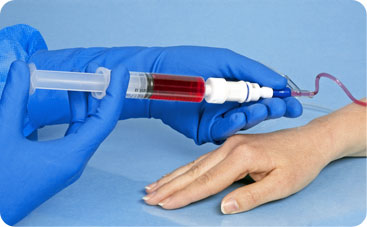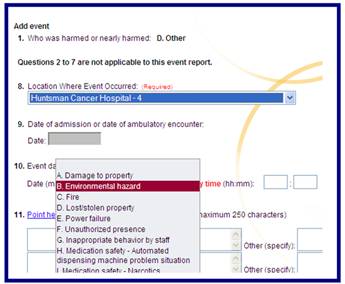Scroll over the picture for safety tips to prevent spills.

How to Handle Hazardous Drug Spills
HCH Nursing Education 2010
This lesson follows University of Utah Heatlh Care's Safe Handling of Hazardous Drugs Policy.
Not all drugs used in the treatment of cancer are considered hazardous.
Hazardous Drug: Any drug identified as causing cancer, teratogenic effects, developmental impairment, reproductive toxicity, organ toxicity, or genotoxicity at low doses in humans or animals. Includes any new drug that is similar to an existing hazardous drug in chemical structure or spectrum of toxicity.
Appendix A of the safe handling policy lists hazardous agents that require safe handling precautions.
Policies have been updated concerning the handling, administration, and extravasation of hazardous drugs. The best way to view the most current policies is through the policy search in intercomm at www.intercomm.utah.edu.
Click the link below and review the policy. Some test questions for this module come from the policy.
www.intercomm.utah.edu
Every person responsible for any aspect of handling hazardous drugs must follow safe-handling practices.
A survey of chemotherapy trained nurses conducted by the Oncology Nursing Society in 2008 found that 55% of trained nurses reported not following established safe handling guidelines when disposing of hazardous drugs.
We all need to be committed to following procedures to reduce exposure in our work environment.
Inadequate cleaning of surfaces after a hazardous drug spill results in surface contamination which increases worker exposure. Surface contamination of the work environment has been documented by 14 seperate studies.
Simple steps may protect you from surface contamination
Do not eat or applying make-up in your work area.
Wash your hands before going on break.
Reasons why health care workers do not comply with national and institutional guidelines:
On average we have one chemotherapy spill per month at Huntsman Cancer Hospital.
SOLUTION--All employees recieve training on the proper cleaning of a hazardous drug spills at hire and every two years.
SOLUTION--Employees use personal protective equipment and a closed system device. PhaSeal is the closed system used at university health care. Phaseal can help to prevent hazardous drug spills and worker exposure.
|
Scroll over the picture for safety tips to prevent spills. |
|
You will be asked at skills day to clean up hazardous drug spill.
Scroll down and read through the steps to cleaning up a hazardous drug spill.
University of Utah Health Care
Hazardous Drug Spill Checklist (for Spill Kit)
|
SAFETY |
1. Stop administration of the drug. 2. Move visitors and family away. 3. Put on PPE; personal protective equipment. Wear 2 pairs of gloves (double glove). 4. Contain the spill a. WET spills—place chemosorb pad or gauze over the spill b. DRY spills—place moist gauze over the spill. 5. Report all spills to Environmental Services: U of U (801) 585-2216; HCH (801) 587-4085 6. Post sign that says "Caution Hazardous Drug Spill." 7. Continue to clean if spill is smaller than a 3X5-inch index card. If spill is larger than 3X5 then: a. Wait for environmental services to arrive. b. Report spill to Hospital Supervisor: U of U (801) 585-2713 or (801) 339-7379 HCH (801) 587-4324 or (801) 339-7982 c. Hospital Supervisor will consider reporting spill to: Emergency Management (801) 585-6121 or on-call person Environmental Health and Safety (801) 581-6590 |
|
CLEAN SPILL |
Spills on Hard Surfaces 1. Remove a. Use scoop to pick up any broken glass. Dispose of glass in biohazard container b. Remove ChemoSorb pad or gauze and place in chemotherapy disposal bag. c. If the spill contains wet urine: before going on to the next steps, dry area completely, using towels in the spill kit. 2. Wash—wash area 2 times with water and soap solution, using towels in the spill kit. 3. Decontaminate—Wipe area with Surface Safe packet #1 then wipe area with Surface Safe packet #2 IMPORTANT: Do NOT use bleach or surface safe on wet urine spills. Harmful gas may form if you mix wet urine with bleach or surface safe. 4. Rinse—Rinse area with water, then blot or wipe dry with towels. Spills on Soft surfaces, including carpet and upholstery are cleaned by environmental services. Bed linens or clothing: Remove linens from bed, change clothing place articles in bag labeled "hazardous drugs". Call environmental services to transport to the laundry. Theses linens will be washed twice. a. For clothing, label the bag with the owner's number, employee department or patient room number and telephone extension. Spills on a Person are cleaned by nursing staff. b. Wash skin for 15 minutes with non-medicated soap and water. c. Rinse eyes and mucous membranes for at least 15 minutes with water. |
|
DISPOSE |
Immediately after cleaning the spill: 1. Place all used cleaning supplies in chemotherapy disposal bag. 2. Place unusable drug bag in black waste bin (RCRA) container. 3. Remove and place all used PPE in the chemotherapy disposal bag. 4. Wash hands then face with soap and water. 5. Order new spill kit. |
|
REPORT |
Complete a patient safety net (PSN) report 1. Access PSN reports through intercom.utah.edu 2. Select OTHER when asked if the report involves a patient visitor or other. 3. Hazardous drug spills are a type B "environmental hazard" event.
|
Click on the drag and drop activity below to test your knowledge.

Click on the slide show activity to see the procedure demonstrated.

You must enter in a PSN report if there is a Hazardous Drug spill.
When Hazardous drug spill is typed in manually, it is difficult to track how many spills we have had.
To enable tracking of spills, please do the following when entering a spill PSN:
-->Access PSN through your links at www.intercomm.utah.edu
Try this in training mode for practice (scroll down):.
|
On the very first PSN screen, choose Other. |
A pop-up will appear, click OK. |
|
|
|
For question number 11. hover over the words point here and choose Environmental Hazard

Enter the details of the event.
Finish entering the PSN as you normally would.
Thank you for helping us track these evets!